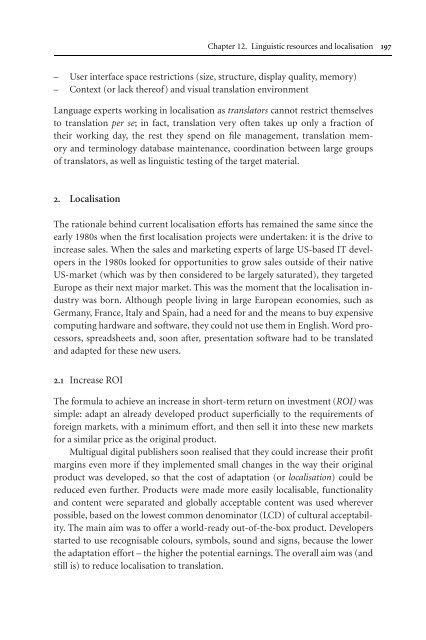Topics in Language Resources for Translation ... - ymerleksi - home
Topics in Language Resources for Translation ... - ymerleksi - home
Topics in Language Resources for Translation ... - ymerleksi - home
- No tags were found...
Create successful ePaper yourself
Turn your PDF publications into a flip-book with our unique Google optimized e-Paper software.
Chapter 12. L<strong>in</strong>guistic resources and localisation 197– User <strong>in</strong>terface space restrictions (size, structure, display quality, memory)– Context (or lack thereof) and visual translation environment<strong>Language</strong> experts work<strong>in</strong>g <strong>in</strong> localisation as translators cannotrestrictthemselvesto translation per se; <strong>in</strong> fact, translation very often takes up only a fraction oftheir work<strong>in</strong>g day, the rest they spend on file management, translation memoryand term<strong>in</strong>ology database ma<strong>in</strong>tenance, coord<strong>in</strong>ation between large groupsof translators, as well as l<strong>in</strong>guistic test<strong>in</strong>g of the target material.2. LocalisationThe rationale beh<strong>in</strong>d current localisation ef<strong>for</strong>ts has rema<strong>in</strong>ed the same s<strong>in</strong>ce theearly 1980s when the first localisation projects were undertaken: it is the drive to<strong>in</strong>crease sales. When the sales and market<strong>in</strong>g experts of large US-based IT developers<strong>in</strong> the 1980s looked <strong>for</strong> opportunities to grow sales outside of their nativeUS-market (which was by then considered to be largely saturated), they targetedEurope as their next major market. This was the moment that the localisation <strong>in</strong>dustrywas born. Although people liv<strong>in</strong>g <strong>in</strong> large European economies, such asGermany, France, Italy and Spa<strong>in</strong>, had a need <strong>for</strong> and the means to buy expensivecomput<strong>in</strong>g hardware and software, they could not use them <strong>in</strong> English. Word processors,spreadsheets and, soon after, presentation software had to be translatedand adapted <strong>for</strong> these new users.2.1 Increase ROIThe <strong>for</strong>mula to achieve an <strong>in</strong>crease <strong>in</strong> short-term return on <strong>in</strong>vestment (ROI) wassimple: adapt an already developed product superficially to the requirements of<strong>for</strong>eign markets, with a m<strong>in</strong>imum ef<strong>for</strong>t, and then sell it <strong>in</strong>to these new markets<strong>for</strong> a similar price as the orig<strong>in</strong>al product.Multigual digital publishers soon realised that they could <strong>in</strong>crease their profitmarg<strong>in</strong>s even more if they implemented small changes <strong>in</strong> the way their orig<strong>in</strong>alproduct was developed, so that the cost of adaptation (or localisation) couldbereduced even further. Products were made more easily localisable, functionalityand content were separated and globally acceptable content was used whereverpossible, based on the lowest common denom<strong>in</strong>ator (LCD) of cultural acceptability.The ma<strong>in</strong> aim was to offer a world-ready out-of-the-box product. Developersstarted to use recognisable colours, symbols, sound and signs, because the lowerthe adaptation ef<strong>for</strong>t – the higher the potential earn<strong>in</strong>gs. The overall aim was (andstill is) to reduce localisation to translation.
















